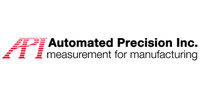 Automated Precision Inc. (API) offers volumetric compensation system (VCS), or volumetric error compensation (VEC) for more complex types of machiness for the volumetric compensation of machine tools. These processes, originally developed together with Boeing, Siemens, and the machine tool manufacturer Fives (formally MAG), increase the volumetric accuracy of a multi-axis machine tool by four to five times. This increase of volumetric tool-tip accuracy can also be accomplished in a single day, which is a significant savings over traditional calibration methods that could take several days. Finally, the volumetric accuracy is done right at the machine tool tip, compared to traditional calibration methods, which don’t.
Automated Precision Inc. (API) offers volumetric compensation system (VCS), or volumetric error compensation (VEC) for more complex types of machiness for the volumetric compensation of machine tools. These processes, originally developed together with Boeing, Siemens, and the machine tool manufacturer Fives (formally MAG), increase the volumetric accuracy of a multi-axis machine tool by four to five times. This increase of volumetric tool-tip accuracy can also be accomplished in a single day, which is a significant savings over traditional calibration methods that could take several days. Finally, the volumetric accuracy is done right at the machine tool tip, compared to traditional calibration methods, which don’t.
Volumetric compensation is essentially an innovative method of assembling the volumetric map on a given machine. Up until now, a typical three-axis machine has used the traditional 21 error parameter method to measure machine-axis errors. Measurements were taken one at a time, along each individual axis, X, Y, and Z.
Each of the three axes has six error parameters: linear position, vertical and horizontal straightness, pitch, yaw, and roll. Each error parameter requires a different setup, and each required its own measurement process. In addition to these 18 error parameters, three more error parameters determine squareness of each of the X, Y, Z axes to each other, X to Y, Y to Z, and Z to X, for the total of 21 error parameters.
Even with the most sophisticated laser, this data acquisition is a long process, and roll in the Z axis must be determined by some other means. If the machine tool has additional axes, like a rotary axis, the calibration time increases rapidly.
Lastly, and in accordance with B5.54-2005, users can perform a diagonal displacement test that in theory measures the volume of the machine tool. This test is also time consuming and is still not a robust indicator of the machines volumetric accuracy.
Solution
API’s approach to the volumetric calibration solution consists of a precision laser tracker with interferometry capability. The interferometer feature of the laser tracker is the same technology traditional laser systems used for years to successfully calibrate machine tools. Coupling the interferometry technology with a laser tracker offers the added capability to track the machine’s tool-tip location through extensive axial movements throughout the entire volume of the machine.
Using the laser tracker and active target, the VEC method measures all 21 error parameters for 200–400 points within the machine’s working volume with all possible machine poses, even with the rotary axis. Each point becomes an accurate reflection of the machine’s kinematic errors. A complex algorithm is used to decouple error sources and build an extremely accurate volumetric map. Error compensation is done by adding the compensation from the entire measured axis to get the best tool-tip position.



